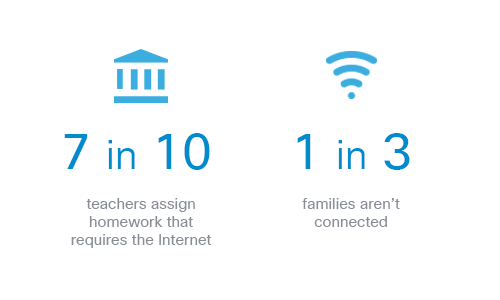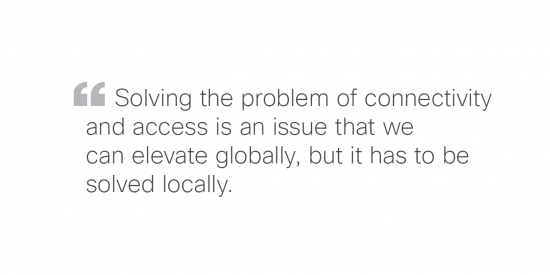































The thoughtful placement of technology in our education environments can greatly enhance the way students learn and educators teach. As we all know, it's possible for students to partake in mobile and distance learning, to access a plethora of remote resources from anywhere on any device, and to extend learning beyond the classroom.
However, with any movement or shift towards digitization comes the creation of a digital divide. Not providing comparable access to all members of the community has severe consequences. Equitable access to resources, content, and experts is essential, especially when talking about the education of the future members of our society.

According to a recent study by CoSN (Consortium for School Networking), 7 in 10 teachers assign homework that requires the Internet, yet 1 in 3 families aren't connected. And, when polled, 51% of principals interviewed said that ensuring access to technology outside of the school is a major challenge.
From an educational perspective, not only is this divide causing inequitable opportunities to complete assignments and perform well in school, but it also squelches the curiosity of students that takes place beyond the traditional school hours.
Studies show that today's learners, the millennial learners, require a learning environment that is personalized, learner-centric, location-agnostic, social and collaborative, time-agnostic, and accessible lifelong. When we look at what's engaging today's students, it becomes apparent that we're doing them a great disservice by not providing equal access to the technology that motivates them.
So, how can we as a society address this growing digital divide?
Change is only possible when implemented with both technological fidelity and appropriate pedagogical shifts. In order for technologies to enable enhanced learning, the digital environment must be reliable, accessible, secure and thoughtfully applied in the curriculum.

Solving the problem of connectivity and access is an issue that we can elevate globally, but it has to be solved locally.
The first and most important step of creating a fully connected community that bridges the digital divide is to create a holistic, common vision. Assess what connectivity can do for your community, and then you can begin to address how to make that happen.
Next, garner community support of this cultural shift. You must secure the support of key stakeholders, partners with traditional and non-traditional constituents as well as the community at large, then you must address the necessary changes in policy and funding models to implement your vision. For sustainability of the community's digital vision, educators have partnered with county supervisors to ensure every new house built has Internet access.
Lastly, bring in trusted technical advisors to help set your vision into motion. At Cisco, we're helping communities architect and design networks that enable current and future engagement.
While our society as a whole has yet to bring equitable access to all, there are some communities who have already begun to bridge the digital divide.

One such community is Imperial County, a southeastern California county with approximately 175,000 residents, 37,000 students, and 64 schools. They built their own last-mile fiber network to support local government functions, the school system and other community needs.
In addition to connecting schools and government buildings in Imperial County, the local public libraries also provide free public access to Wi-Fi, even after hours. Computers are available that enable citizens to look for jobs, apply for jobs, write resumes, and more. For K-12 students, both live and remote tutorial and homework assistance are available.
Imperial County has demonstrated that even remote communities can effectively plan, build, and manage the full benefits of a community-owned fiber IT infrastructure, leverage strategic partnerships, seek technical expertise, and achieve economies of scale for rural and remote communities.
And they're not the only ones. We have partnered with many more communities making similar shifts, and in the future, we will continue to partner with innovative communities and school districts around the country, ensuring that the digital divide will no longer inhibit equitable access and learning for the next generation of students.
 Etiquetas calientes:
educación
Transformación Digital
conectividad
K12 Education
digital inequality
Etiquetas calientes:
educación
Transformación Digital
conectividad
K12 Education
digital inequality